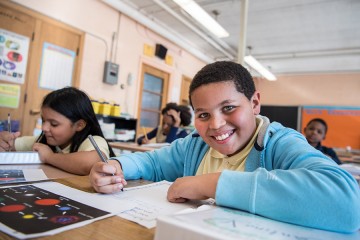The one-size-fits-all approach to identifying students who might thrive in the Johns Hopkins Center for Talented Youth's programs wasn't working in the center's own backyard. Seeing "abysmal" qualifying rates among Baltimore students, according to interim executive director Amy Shelton, the center partnered with Baltimore City Public Schools to launch the CTY Baltimore Emerging Scholars program. Now in its sixth year, the school-based enrichment program provides bright students with advanced learning and serves as a test of alternative methods to identify students with high potential.
The numbers don't lie
There's typically a two-step process for admission to CTY's gifted education programs. A student is first identified as a high-achiever—someone who's curious, investigative, or working well ahead of their peers academically—and then takes an above-grade-level assessment to determine the extent of their ability in a subject area such as math or verbal reasoning. About 75% of students who meet both criteria qualify for CTY programming, either at one of its 24 Summer Programs sites or online.
But in Baltimore, qualifying rates were closer to 25%, says Shelton, who is also CTY's director of research. "There's no reason to believe that there are fewer really bright students" in Baltimore, she says. "And so the question was, What do you do in a population where they may not be getting enough opportunities to actually demonstrate their higher ability?"
Alternative to testing
Shelton acknowledges that standardized tests are not always the best method for evaluating a student's ability. But if those tests are used to predict how well a student will fare in CTY programming, she explains, then perhaps an alternative would be to put students into a program that offers similar opportunities for growth and discovery, and directly observe how they fare.
That's the concept behind CTY Baltimore Emerging Scholars, which takes this nontraditional tack to identify advanced learners who might not qualify via above-grade-level standardized tests. Between October and May, select students in grades two through five at 21 Baltimore City schools meet for an hour and a half each week for hands-on, interdisciplinary activities centered around themes. Second graders in "Shaping Our World: Early Architecture," for instance, focus on conceptualizing and building a model of a new school playground. One week might be a deep dive on the history of playgrounds, another might be a lesson about how to represent three-dimensional shapes in 2D, and another might be a discussion on how best to get community buy-in for their proposal.
The center's staff members work closely with educators at each school, training them in how to select children for the program, lead the curriculum, and assess which students display qualities that indicate readiness for CTY programming.
More equitable admissions
Just 3% of Emerging Scholars would have qualified for CTY through standardized testing. But using teacher evaluations at the end of each Emerging Scholars term increases that number to about 70%, more closely aligning with national qualifying rates.
"Alongside that, we treat [the program] like a talent search and say, 'Well, are there other measures that would have shown us those kids, had you tested them differently?'" Shelton says. The center's research team is investigating whether Emerging Scholars students have cognitive skills comparable to those identified through traditional methods, for instance, whether they share advanced spatial skills or critical thinking. What they discover could ultimately lead to new methods for identifying talent, not just in Baltimore but nationwide.
Posted in Politics+Society
Tagged education, center for talented youth









